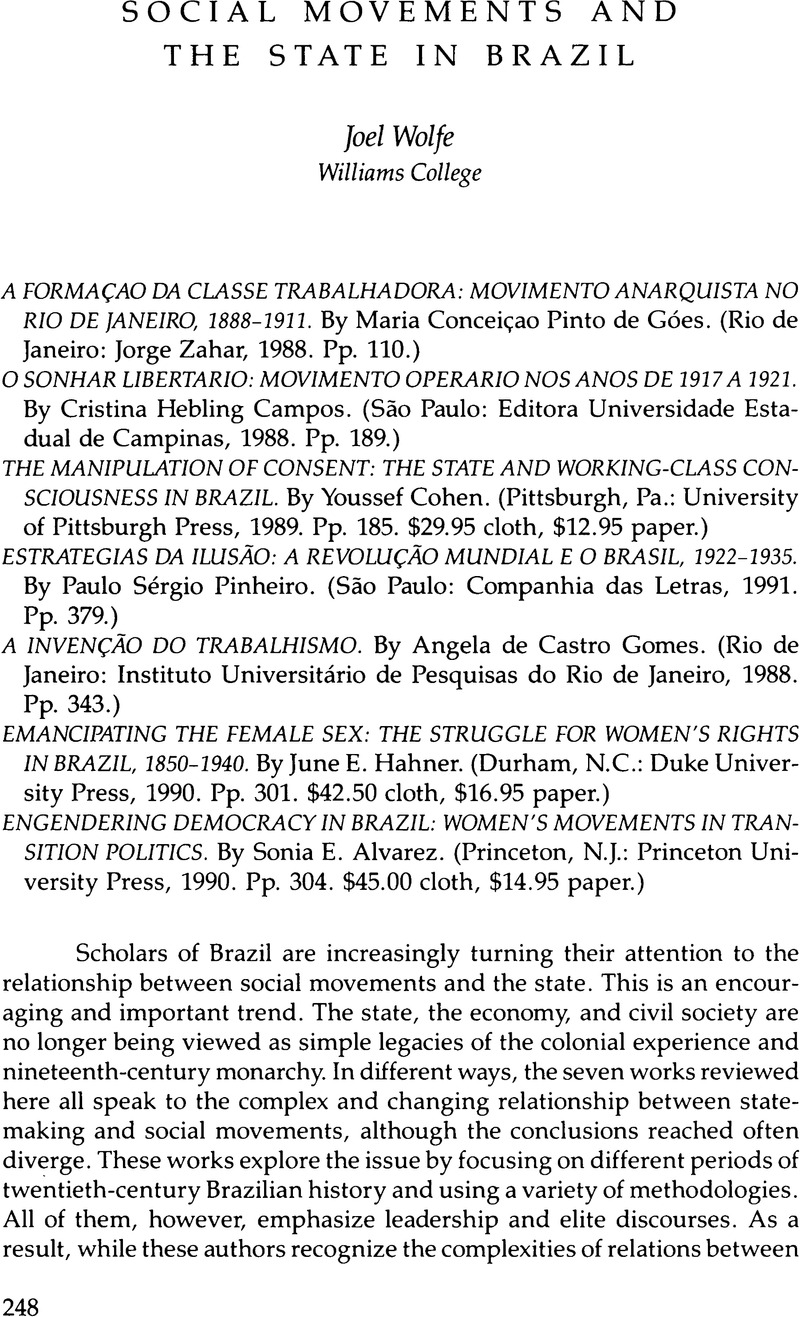Article contents
Social Movements and the State in Brazil
Review products
Published online by Cambridge University Press: 12 October 2022
Abstract

- Type
- Review Essays
- Information
- Copyright
- Copyright © 1993 by Latin American Research Review
References
Notes
1. Because Rio was the national capital, the organizing and protest activities of Cariocas seem to have had greater political impact than the actions of workers in other cities. This topic remains regrettably understudied. On popular participation in various forms of Rio politics, see José Murilo de Carvalho, Os Bestializados: O Rio de Janeiro e a República Que Não Foi (São Paulo: Companhia das Letras, 1987); Jeffrey D. Needell, “The Revolta Contra Vacina of 1904,” Hispanic American Historical Review 67, no. 2 (May 1987):233–69; and Michael L. Conniff, Urban Politics in Brazil: The Rise of Populism, 1925–1945 (Pittsburgh, Pa.: University of Pittsburgh Press, 1981).
2. The intense ethnic and racial divisions within the Carioca working class are detailed in Sidney Chalhoub, Trabalho, Lar e Botequim: O Cotidiano dos Trabalhadores no Rio de Janeiro da Belle Epoque (São Paulo: Brasiliense, 1986); and Sheldom Maram, Anarquistas, Imigrantes e o Movimento Operário Brasileiro, 1890–1920 (Rio de Janeiro: Paz e Terra, 1979), among others. On racial divisions in São Paulo, see George Reid Andrews, “Black and White Workers: São Paulo, Brazil, 1888–1928,” Hispanic American Historical Review 68, no. 3 (Aug. 1988):491–524. On the impact of divisions by sex and gender ideologies, see Joel Wolfe, “Anarchist Ideology, Worker Practice: The 1917 General Strike and the Formation of São Paulo's Working Class,” Hispanic American Historical Review 71, no. 4 (Nov. 1991):809–46.
3. Foucault's influence can also be detected among Brazilians studying how gender is socially constructed. Two recent examples of this trend are Martha de Abreu Esteves, Meninas Perdidas: Os Populares e o Cotidiano do Amor no Rio de Janeiro da Belle Epoque (Rio de Janeiro: Paz e Terra, 1989); and Margareth Rago, Os Prazeres da Noite: Prostituição e Códigos da Sexualidade Feminina em São Paulo, 1890–1930 (Rio de Janeiro: Paz e Terra, 1991).
4. For Foucault's discussion of Jeremy Bentham's “Panopticon,” see Foucault, Discipline and Punish: The Birth of the Prison, translated by Alan Sheridan (New York: Vintage, 1979), 195–228. Although Pinto de Góes and Campos refer to Foucault, their analyses of power seem to owe more to Gramscian notions of hegemony than to the ideas of Foucault, who believed that all forms of repression and control contain the possibility for resistance to them.
5. Two recent examples of such studies are Linda Gordon, Heroes of Their Own Lives: The Politics and History of Family Violence (New York: Vintage, 1988); and Regina G. Kunzel, “The Professionalization of Benevolence: Evangelicals, Social Workers, and Unmarried Mothers, 1890–1945,” Ph.D. diss., Yale University, 1990. On the debate over social control, see Linda Gordon, “Family Violence, Feminism, and Social Control,” Feminist Studies 12 (Fall 1986):453–78.
6. It should be pointed out that one of the disservices of this book is its impenetrable style of source notation, which resulted from the many years that Pinheiro spent writing the book. The other problem is the failure to provide a bibliography.
7. On the PCB's opposition to strikes, see Leôncio Basbaum, História Sincera da República de 1930–1960, 4th ed. (São Paulo: Alfa-Omega, 1976), 182–85. The PCB's support of Vargas's corporatist structure and a call to suffer through the hard times is presented in João Amazonas, Pelo Fortalecimento e Unidade Sindical (Rio de Janeiro: Horizonte, 1945).
8. One such study details the weakness of Vargas's political machine in São Paulo. See Maria Victória Benevides, O PTB e o Trabalhismo: Partido e Sindicato em São Paulo, 1945–1964 (São Paulo: Brasiliense, 1989).
9. Susan K. Besse provides a fascinating account of changing social mores for middle-class and elite Paulistanas in “Freedom and Bondage: The Impact of Capitalism on Women in São Paulo, Brazil, 1917–1937,” Ph.D. diss., Yale University, 1983.
10. This problem does not affect Pinheiro's work because he does not attempt to analyze a social movement. Instead, he details some of the reasons why Brazilian workers ended up not joining the PCB.
11. Alvarez is careful to detail conflicts among feminist activists throughout her book.
12. For an informative analysis of the tension between grass-roots organizing and the process of institutionalization, see Frances Fox Piven and Richard A. Cloward, Poor People's Movements: Why They Succeed and How They Fail (New York: Pantheon, 1977). See also Eric Hobsbawm's thoughtful critique in the New York Review of Books, 23 Mar. 1978, 44–50.
13. Students of urban social movements should also start to consider the impact of rural organizing and protest activities on individuals before they migrated to cities. Two recent studies of rural social movements are Todd A. Diacon, Millenarian Vision, Capitalist Reality: Brazil's Contestado Rebellion, 1912–1916 (Durham, N.C.: Duke University Press, 1991); and Clifford Andrew Welch, “Rural Labor and the Brazilian Revolution in São Paulo, 1930–1964,” Ph.D. diss., Duke University, 1990.
14. Two works in Latin American labor history that analyze the problematic relationship of the rank and file with union and political leaders are Peter Winn, Weavers of Revolution: The Yarur Workers and Chile's Road to Socialism (New York: Oxford University Press, 1986); and Daniel James, Resistance and Integration: Peronism and the Argentine Working Class (Cambridge: Cambridge University Press, 1988).
- 1
- Cited by




